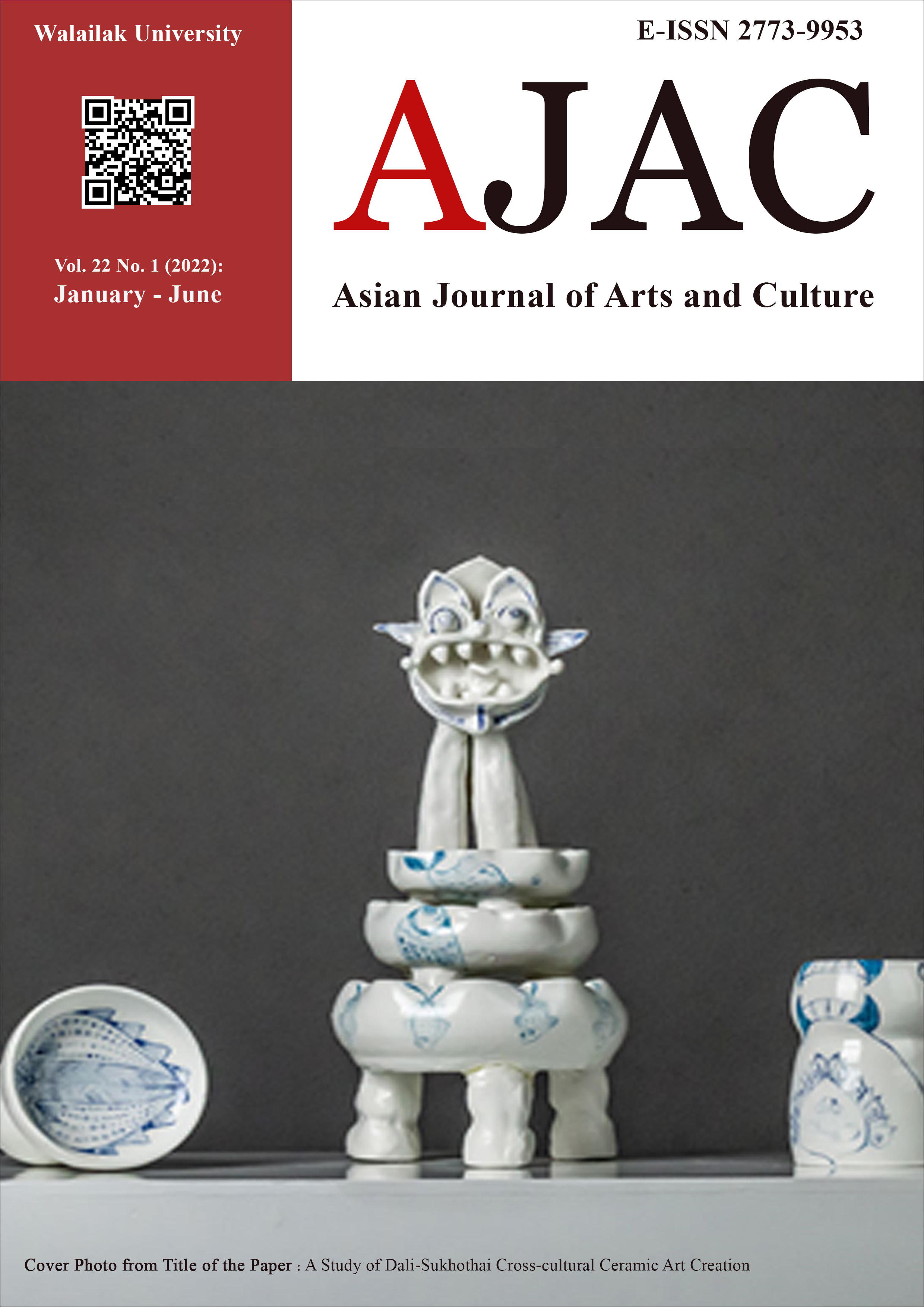Developing the framework of harmonised shape grammar to regenerate traditional textile patterns
Main Article Content
Abstract
Thailand. Its lower section (“tin chok”) is a woven fabric comprising frieze patterns. Harmonised Shape Grammar (HSG) can assist in the design process to achieve harmonized and meaningful designs. We developed the generic framework of HSG to suit a specific context, so that the pattern sets in “tin chok” can be regenerated. We applied this framework to six pattern sets decoded from vintage skirts. This framework consists of five levels of analysis (identifying shape elements, identifying fundamental units, identifying/ understanding a set of rules, generating frieze patterns, arranging frieze patterns on the design structure). We find that their shape elements can be classified into trilateral shapes and quadrilateral shapes. There are 24 fundamental units confined to rectangular spaces. “Tin chok” is designed to have four parts: a main part, two supplementary parts and a hem. By applying the rules of seven frieze groups, a fundamental unit for each part can be generated to seven design derivations. There are 28 possibilities for design derivations per set. However, only 12 possibilities for design derivations appear. Among these, only three out of seven frieze groups are employed.
Article Details

This work is licensed under a Creative Commons Attribution-NonCommercial-NoDerivatives 4.0 International License.
© 2018 by Asian Journal of Arts and Culture, Walailak University. All rights reserved.
References
Allen, J. (1995). Natural Language Understanding. San Francisco, USA: The Benjamin Cummings Publishing Company, Inc.
Chudasri, D., Walker, S., & Evans, M. (2020). Potential areas for design and its implementation to enable the future viability of weaving practices in Northern Thailand. International Journal of Design, 14(1), 95–111.
http://www.ijdesign.org/index.php/IJDesign/article/viewFile/3128/883
Conway, S. (1992). Thai Textiles. London, UK: British Museum Press.
Gilsdorf, T. (2012). Introduction to Cultural Mathematics: with Case Studies in the Otomies and Incas. New Jersey, USA: John Wiley & Son, Inc.
Hann, M. A. (1992). Symmetry in Regular Repeating Patterns: Case Studies from Various Cultural Settings. The Journal of The Textile Institute, 83(4),579-590.
Hann, M. A. (2013). Symbol, Pattern & Symmetry – The cultural significant of structure. London, UK: Bloomsbury.
Hann, M. A., & Thomson, G. M. (1992). The Geometry of Regular Repeating Pattern. Textile Progress, 22(1),1–62.
Harris, M. D. (1985). Introduction to Natural Language Processing. Virginia, USA: Reston Publishing Company, Inc.
Intangible Cultural Heritage. (2019). Intangible Cultural Heritage. Retrieved from http://ich.culture.go.th/index.php/en
Knight, T. (2000). Introduction to Shape Grammars, MIT/Miyagi workshop: Lecture notes, pp. 7-12.
Kunkhet, A. (2015). Harmonised Shape Grammar in Design Practice. (Ph.D. Dissertation Staffordshire University, UK.)
Liddy, E., D. (2001). Natural Language Processing. In: Encyclopaedia of Library and Information Science, 2nd Ed., New York, USA: Marcel Dekker, Inc.
Ministry of Culture. (2009). Seminar of progressing from the cultural capital to the creative economy. Bangkok, Thailand.
Oxford University Press. (2019). patter. Retrieved from https://en.oxforddictionaries.com/
Shubnikov, A., & Koptsik, V. (1974). Symmetry in Science and Art. New York, USA: Springer Verlag.
Stiny, G. (2006). Shape: Talking about Seeing and Doing. London, UK: MIT Press.
Stiny, G., & Gips, J. (1972). Shape Grammars and the Generative Specification of Painting and Sculpture. Proceedings of IFIP Congress, 7(1), pp. 1460-1465.
Study.com. (2021). Rigid Motion in Geometry. Retrieved from https://study.com/academy/lesson/rigid-motion-in- geometry.html
Walker, S., Evans, M., Cassidy, T., Jung, J., & Holroyd, A. T. (2018) Design Roots: Culturally Significant Designs, Products and Practices. London, UK: Bloomsbury.
Washburn, D., & Crowe, D. (1988). Symmetries of Culture: Theory and Practice of Plane Pattern Analysis. London, UK: University of Washington Press.


